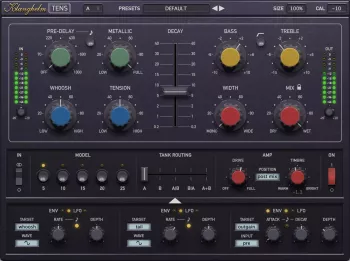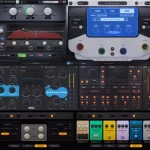Klanghelm TENS v1.1.2 TENS has been physically modeled after the range of high end studio spring reverberation units introduced by a famous Austrian company from the early 1970s to early 1980s. As opposed to classic spring reverbs found in guitar amps, these units were based on the company’s own patented proprietary design principle, which allowed various connected spring elements of different lengths and wire diameter to vibrate inside a small isolated space. The spring elements were manipulated in various ways, e.g. by etching the wire surface and deforming individual turns of the coil wire resulting in a highly diffused, and very dense reverb, that didn’t expose the boing/chirping artifacts associated with spring reverbs and brought it much closer to the sound of plate reverbs. This range of reverbs is praised for its incredibly deep, organic, complex, rich, smooth and floating character. In terms of sound (but of course not technically) it can been seen as the missing link between classic spring and plate reverbs. A very unique beast indeed!
TENS has been physically modeled after the range of high end studio spring reverberation units introduced by a famous Austrian company from the early 1970s to early 1980s. As opposed to classic spring reverbs found in guitar amps, these units were based on the company’s own patented proprietary design principle, which allowed various connected spring elements of different lengths and wire diameter to vibrate inside a small isolated space. The spring elements were manipulated in various ways, e.g. by etching the wire surface and deforming individual turns of the coil wire resulting in a highly diffused, and very dense reverb, that didn’t expose the boing/chirping artifacts associated with spring reverbs and brought it much closer to the sound of plate reverbs. This range of reverbs is praised for its incredibly deep, organic, complex, rich, smooth and floating character. In terms of sound (but of course not technically) it can been seen as the missing link between classic spring and plate reverbs. A very unique beast indeed!
To extend the sonic possibilities of the originals, TENS offers:
– a wide range of decay times (from 0.2 seconds up to 40 seconds)
– as opposed to the original each tank of TENS’ models outputs a stereo signal instead of mono
– various options to deeply alter the actual models via the TENSION, WHOOSH and METALLIC controls
– optional (pre-)amp saturation, that can be placed freely in the signal chain
– three modulation slots to add movement or create out-of-this-world sounds
– every continuous TENS parameter can be a modulation target
– the target can be modulated by either an LFO or envelope follower
– the envelope follower can be triggered by either the reverb input, ouput or even an external sidechain signal
– using the envelope follower for ducking effects is also possible
– the envelope follower can be used to shape the dynamics of the input, the optional amp saturation and the reverb signal
– with the modulation section various modulation effects can be achieved, such as tremolo, chorus, vibrato, phaser-like sounds and more rather unusual sounds plus combinations of the aforementioned effects
Brief history of the units, TENS was modelled after\
It all started in 1972 with the release of the BX20. With the size of a fridge it still had a much smaller footprint than the available plate reverbs at that time.\
In 1975 the BX10 followed. It was designed to be a portable version, where the carry handle could be used to lock the tanks for transport. It had a much smaller footprint than its predecessor.\
By the end of the 1970s the 3u rackmount version BX5 has been released. It was the most affordable model of the BX line.\
1982 saw the release of the BX25 model. This incarnation of the BX range managed to increase the spring length by about 20%, while reducing the enclosure size by about 60% compared to the BX20 model. the BX25 included an inbuilt delay, which was intended to be used as a pre-delay for the reverb. The BX15 had been released the same year. It was built upon the BX10, and offered more selectable decay times and stepped controls for the EQ section of the unit.
TENS is available in the following formats (all included in a single license):\
\
Windows 8 or higher (64bit): VST, VST3, AAX Native for ProTools® 11 or higher\
macOS 10.11 or higher: AU, VST, VST3, AAX Native for ProTools® 11 or higher
** All third party trademarks, brands, products references are trademarks of their respective owners. The use of these trademarks is only referential and only used to describe the products, that have been studied and modelled during the the process of creating TENS using Klanghelm’s own modelling techniques. Klanghelm is in no way affiliated, endorsed or sponsored by any of the mentioned third parties.*

![BLEASS Arpeggiator v1.0.17 [WIN]](https://www.goaudio.net/wp-content/uploads/2023/12/BLEASS-Arpeggiator-60x60.jpeg?v=1701474383)
![Unfiltered Audio LION v1.5.0 [WIN]](https://www.goaudio.net/wp-content/uploads/2023/12/Unfiltered-Audio-LION-v1.5.0-60x60.webp)





![Toontrack Hollowbody EBX [WIN+MAC]](https://www.goaudio.net/wp-content/uploads/2024/09/Toontrack-Hollowbody-EBX-150x150.png?v=1726103695)
![Toontrack LATEST RELEASES MIDI BUNDLE [SEP 2024]](https://www.goaudio.net/wp-content/uploads/2024/09/gandr-collage-11-150x150.jpg?v=1725764744)
![Blockbuster Sound Sand Dune & Mockingbird [BUNDLE]](https://www.goaudio.net/wp-content/uploads/2024/08/blockbuster-sound--150x150.png?v=1724378090)

![Blockbuster Sound Mermaids Sirens & Horror Pack [BUNDLE]](https://www.goaudio.net/wp-content/uploads/2024/08/Blockbuster-Sound-150x150.png?v=1723854097)



![AEJuice I Want To Learn It All Bundle 2024 [NEW]](https://www.goaudio.net/wp-content/uploads/2024/12/juice-150x150.webp)


